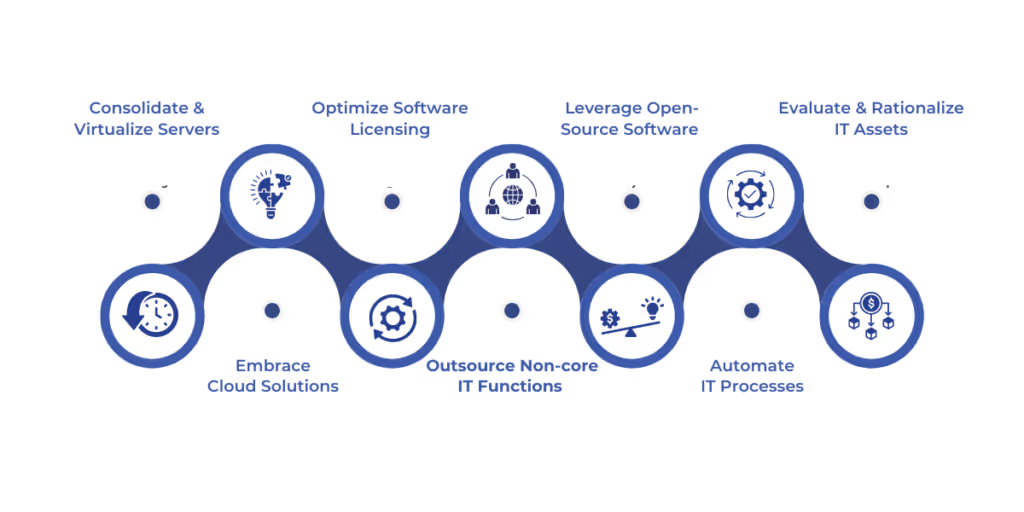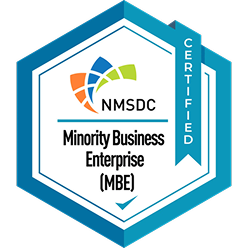


IT spending is rising, but is every dollar spent truly necessary?
A Gartner report predicts that global IT spending will reach $5.61 trillion in 2025. Yet, many businesses invest up to 32% of their IT budgets on redundant tools, underutilized software, and inefficient processes.
In a time when efficiency dictates profitability, cutting unnecessary IT costs isn’t just about saving money; it’s about ensuring sustainable growth. From optimizing cloud usage to refining vendor contracts, businesses must adopt smarter strategies to maintain agility without compromising performance.
In this blog, we will explore IT cost reduction strategies that will help you trim IT expenses while keeping your technology infrastructure strong and future-ready! Let’s start with the basics.
IT cost reduction in business refers to the strategic process of minimizing expenses associated with technology infrastructure, software, services, and operations. It involves evaluating current IT expenditures, identifying inefficiencies, and implementing cost-saving measures without compromising system performance, security, or business continuity.
This process may include:
IT cost reduction is important to improve business efficiency. By adopting structured cost-cutting measures, businesses can streamline their IT budgets while maintaining operational effectiveness.
Understanding the fundamentals of IT cost reduction sets the foundation for exploring why structured cost-saving strategies are crucial for long-term financial stability and technological resilience. Now, let’s see the importance of implementing the strategies.

Effective IT cost reduction strategies are essential for financial stability, operational efficiency, and long-term business growth. They help organizations allocate resources wisely, eliminate unnecessary expenses, and ensure that technology investments provide maximum value. Here’s why structured IT cost reduction is crucial:
Uncontrolled IT expenses can strain a company’s budget, leading to unnecessary financial burdens. By optimizing IT spending, businesses can free up capital for core operations, innovation, and expansion while reducing the risk of budget overruns and unexpected costs.
Cost-cutting measures such as automation, cloud optimization, and software consolidation help businesses enhance efficiency by eliminating redundant processes. This allows IT teams to focus on strategic initiatives instead of managing excessive software, hardware, or outdated legacy systems.
Many businesses overspend on IT resources due to underutilized software licenses, redundant infrastructure, or inefficient cloud usage. A structured cost-reduction approach ensures that businesses only pay for what they actually need, maximizing returns on IT investments.
High IT costs can limit a company’s ability to adapt to market changes or invest in new technologies. Strategic cost reduction ensures that IT budgets remain flexible, allowing businesses to respond to evolving industry demands and technological advancements.
Reducing IT costs doesn’t mean cutting corners on security. Instead, businesses can allocate funds more effectively to ensure compliance, strengthen cybersecurity, and adopt cost-efficient security solutions that protect against data breaches and regulatory penalties.
Sustainable cost-saving strategies align IT spending with business goals, ensuring that technology investments are future-proof. By eliminating outdated and costly infrastructure, businesses can focus on scalable, high-value digital transformation initiatives.
Implementing IT cost reduction strategies is all about making strategic, data-driven decisions that improve efficiency and drive growth. Now, let’s explore seven practical strategies to reduce IT costs while maintaining business performance.

By adopting smart budgeting, automation, and cloud management, organizations can cut unnecessary costs while ensuring their IT infrastructure remains scalable and future-ready. Here are the top IT cost reduction strategies:
Server consolidation and virtualization reduce hardware costs, energy consumption, and maintenance expenses by running multiple workloads on fewer physical servers. This approach optimizes resource utilization, enhances scalability, and simplifies IT management.
With fewer servers, businesses can lower operational costs, improve efficiency, and strengthen disaster recovery capabilities while maintaining high performance. Here is how to implement it:
Migrating to cloud solutions helps businesses reduce infrastructure costs, eliminate expensive on-premise hardware, and optimize IT resource allocation. Cloud services offer scalability, pay-as-you-go pricing, and automated maintenance, ensuring cost efficiency.
By leveraging cloud-based storage, computing, and applications, businesses can enhance flexibility, improve security, and lower operational expenses. Here is how to implement it:
Optimizing software licensing helps businesses eliminate unnecessary expenses, prevent non-compliance penalties, and ensure efficient software utilization. Many organizations overspend on unused or redundant licenses.
By auditing software usage, renegotiating vendor contracts, and adopting subscription-based models, businesses can reduce costs while maintaining access to essential tools and applications. Here is how to implement it:
Outsourcing non-core IT functions helps businesses reduce operational costs, improve efficiency, and focus on strategic initiatives. By delegating tasks such as helpdesk support, infrastructure management, organizations can access expert services at lower costs while minimizing the need for in-house IT resources. Here is how to implement it:
Using open-source software helps businesses eliminate expensive licensing fees, reduce dependency on proprietary solutions, and maintain flexibility in IT operations. Many open-source tools offer robust security, customization options, and community-driven support.
It allows organizations to cut costs while ensuring high-quality performance, scalability, and continuous improvements through developer contributions. Here is how to implement it:
Automating IT processes helps businesses reduce manual effort, minimize errors, and lower operational costs. This strategy streamlines tasks such as software deployment, system monitoring, and cybersecurity management. It helps organizations enhance scalability and optimize resource utilization while freeing IT teams to focus on higher-value initiatives. Here is how to implement it:
Evaluating and rationalizing IT assets helps businesses identify underutilized resources, eliminate redundant systems, and optimize technology investments. By implementing this strategy, organizations can reduce unnecessary costs, improve efficiency, and ensure that IT resources align with business objectives. Here is how to implement it:
Implementing these IT cost reduction strategies helps businesses streamline operations, eliminate unnecessary expenses, and enhance overall efficiency. A proactive approach to optimizing IT investments ensures long-term financial stability while maintaining performance and security.
Properly reducing IT expenditures requires a strategic, well-planned approach that balances cost savings with operational efficiency. Rather than implementing short-term cuts, businesses must prioritize long-term strategies. A holistic approach to managing technology assets ensures that IT investments remain aligned with business goals, minimizing waste and maximizing value. IT cost reduction strategies are key to maintaining financial stability and future-proofing technology operations.
For effective IT management strategies, try WaferWire for advanced multi-cloud IT solutions. We offer multiple cloud environments for enhanced performance and cost efficiency. You can optimize resources and drive operational agility with WaferWire’s expert guidance. Contact us today to access personalized cloud solutions specially tailored for your business!

